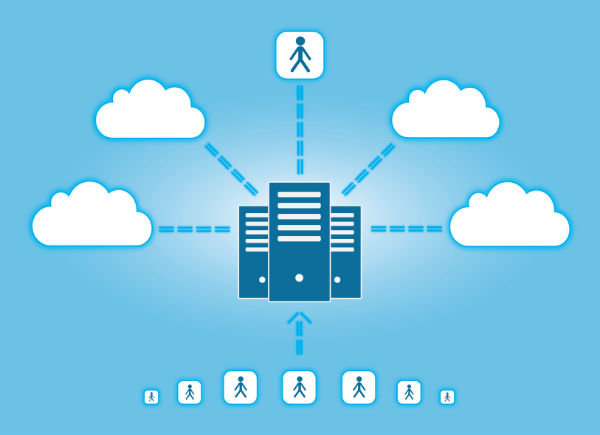
The EPA estimates over 12 million laptop computers were discarded in 2007. That’s over 32,875 laptops tossed in the trash each day. Imagine a future where we can somehow reign in all this electronic waste, and perhaps one day eliminate it completely. The answer may be in cloud computing.
Imagine in the future that instead of traveling with a laptop computer, you grab your personal wireless interface (PWI) — probably something made of fabric you can crumple up and stuff in your pocket, but for want of a better analogy, think of a keyboard, mouse and screen.
With your PWI you can connect instantly to the Internet without wires or even electricity. Wherever you are, you’ll have access to all your software and files, which will be protected by encryption technology. You’ll do all your work “in the cloud” and you’ll never need to worry about losing work.
I can’t wait for that day to come, because I’m tired of lugging around my laptop. I’m worrying about it constantly. What if I drop it? What if something gets spilled on it? Or, what if I lose it, or someone steals it? And now, knowing how much e-waste is generated each year just from laptop computers, I don’t want to continue to be part of the problem.
For all their convenience, laptops just aren’t all that convenient. Even more, they’re bad for the environment.
Cloud computing, on the other hand, is a genius invention that can help save the earth. Cloud computing is very convenient: you’ll never need to install or upgrade software again, because it’s done for you in the cloud, and you can easily share your files if your work requires multiple users. No more emailing around countless revisions!
For the past week I’ve had the opportunity to leave my laptop behind and do an experiment with cloud computing. With a computer at work and occasional stretches of down time, I’ve been wondering how productive I could be without a personal computer of my own.
As I ponder buying another computer within the next 12-24 months, I wonder if it will even be necessary to own a personal computer in the near future. Will every piece of software be available in the cloud? How cool will it be never to have to throw away another outdated computer?
Clouds have been around for a while, but with server technology getting more powerful, and Internet connectivity becoming faster and more accessible all the time, the implications of cloud computing are eventually going to lead us to complete freedom from notebook computers and software upgrades.
You’ve probably been using cloud computing for years. Big Web email providers like Gmail, Hotmail, Yahoo, etc. were some of the first examples of cloud computing. Social media sites like Facebook and Twitter also use a cloud computing model. When you update your Facebook or Twitter status, you don’t have to go around and change something in everyone’s computers. Your profiles exist in the cloud. When you change something, everyone can see the change instantly.
One of the most exciting examples of cloud computing comes from Veeple, a Palo Alto, CA-based company that offers “clickable video” technology to producers and Web publishers. With Veeple, you can program clickable elements into a video and offer an enhanced interactive experience, with pop-up bubbles, online shopping and more. Software upgrades are installed by Veeple in the background, and when you change a link in a Veeple video, viewers see the new link immediately, even if your video has already been deployed. In this example, cloud computing will help save millions in costs and materials for advertisers and publishers.
In the last few days, I’ve written, edited and submitted several articles, ordered domain names, set up hosting accounts, shopped for accessories and kept up with my emails — all without having my own computer on hand — thanks to cloud computing.
It may not be as quick as two years from now before laptop computers become a thing of the past. For now, we still need our laptops to access the cloud (I used other people’s desktop computers to access the cloud). But, in the future, we won’t need smaller computers to access bigger computers; instead, we’ll have something very simple without information or complicated components, like the PWI imagined earlier. This will make upgrades and computer disposal a thing of the past.
From a conservation angle, we’re probably talking hundreds of millions of pounds of saved materials each year, once it is no longer necessary to build personal computers for every human being. Imagine how much less e-waste we will create when everybody is using cloud computing.
Remember the statistic from the EPA that 12 million laptops were discarded in 2007? Including desktop computers, nearly 30 million computers were discarded that year. Combined, we’re talking about 112,000 computers discarded every single day.
I sure haven’t missed my laptop during this experiment, and in fact, I’ll be looking for even more ways to work in the cloud.
If we move toward a personal computing model that no longer requires personal computers, cloud computing can make a big impact in our efforts to combat e-waste.


